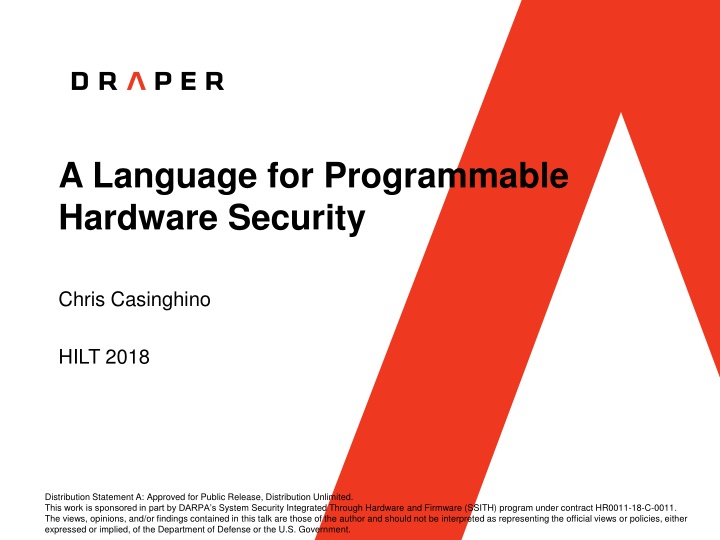
Programmable Hardware Security for Configurable Policies
Explore the language and tools needed to program configurable hardware security features for adaptable defense against evolving software threats. Learn about Draper's PIPE co-processor, programmable metadata tags, and more in this insightful presentation.
Download Presentation

Please find below an Image/Link to download the presentation.
The content on the website is provided AS IS for your information and personal use only. It may not be sold, licensed, or shared on other websites without obtaining consent from the author. If you encounter any issues during the download, it is possible that the publisher has removed the file from their server.
You are allowed to download the files provided on this website for personal or commercial use, subject to the condition that they are used lawfully. All files are the property of their respective owners.
The content on the website is provided AS IS for your information and personal use only. It may not be sold, licensed, or shared on other websites without obtaining consent from the author.
E N D
Presentation Transcript
A Language for Programmable Hardware Security Chris Casinghino HILT 2018 Distribution Statement A: Approved for Public Release, Distribution Unlimited. This work is sponsored in part by DARPA s System Security Integrated Through Hardware and Firmware (SSITH) program under contract HR0011-18-C-0011. The views, opinions, and/or findings contained in this talk are those of the author and should not be interpreted as representing the official views or policies, either expressed or implied, of the Department of Defense or the U.S. Government.
Overview What languages and tools should we use to program configurable hardware security features? The plan in three parts: 1. Configurable hardware security features ? 2. How are we doing it right now? 3. What are the next steps? 2
DARPA SSITH/HOPE Team Arun Thomas, Chris Casinghino, Arch Owen, Curtis Walker UPenn MIT Portland State Andr DeHon Benjamin Pierce Howard Shrobe Andrew Tolmach Dover Microsystems Dornerworks INRIA Greg Sullivan Andrew Sutherland Nathan Studer C t linHri cu 3
Problem: Hardware doesnt adapt. Software security models and attacker techniques change often. Hardware can provide strong security guarantees for software. But today s hardware security features defend against yesterday s threats. SMEP (2011) SMAP (2012) MPX (2013) SGX1 (2013) SGX2 (2014) MPK (2015) CET (2016) Recent Intel Security Feature Timeline Solution: design hardware to enforce a configurable policy. 5
Configurable security: Drapers PIPE PIPE is a security co-processor that monitors your application processor. Programmable Metadata Tags Each data word has a programmable tag. Can t be modified by user application. Micro-policies Define security, safety, or correctness requirements. Processor Interlocks for Policy Enforcement (PIPE) Unassailable hardware interlock enforces policies. Runs parallel to application processor. 6
Key Idea 1: Metadata Tags Each memory word and register has a programmable metadata tag. Instruction, user data, etc. metadata tag data payload At every instruction, tags for the relevant memory and registers are passed to the PIPE. Example metadata: Provenance Access rights Object type Executable? Legal branch target? Buffer bounds Application cannot directly create or modify tags. Tags can be pointers to arbitrary data structure, enabling complex policies. 7
Key Idea 2: PIPE hardware The PIPE runs in parallel with usual application processor. Its inputs are metadata tags, which are evaluated against a defined policy. Generates application processor interrupt if policy violation occurs. Creates unassailable hardware interlock blocking execution of bad instructions. Cache keeps performance high. 8
RISC-V Inside Today we re building on RISC-V. RISC-V Cores RISC-V is an open architecture, great for experimentation. Also beginning to see use in practice; we re optimistic. Work also in progress on ARM, other RISC architectures (PowerPC, MIPS) possible. 9
Key Idea 3: Micro-policies Example Policies Policies define what instructions are allowed and how metadata is updated. Heap Safety Policies are written in a domain- specific rule language. Read-Write-Execute Control-flow Integrity PIPE sends metadata tags to policies running on the policy execution core. Compartmentalization Information Flow Control Policies check metadata against installed rules and reject bad behavior. Domain-specific policies 10
Micro-policy Example Policy Goal: enforce spatial and temporal safety Method: color pointers and memory - On allocation, add colors to the region and the pointer. - Recolor on free. Policy: When accessing memory, the pointer and the region must have the same color. 11
PIPE History and Foundation In 2010, DARPA launched 5-year, $100M CRASH program ( Clean-Slate Design of Resilient, Adaptive Secure Hosts ). Largest effort let by team at BAE Systems, built new SAFE architecture. DARPA CRASH The SAFE team joined Draper in 2015 to take 5 years of research into practice. Large Draper internal investment over 2 years resulted in redesign as add-on modifications for existing cores. Technology built on open, emerging RISC-V architecture for initial development. In 2017, spin-out Dover Microsystems created to pursue commercial markets and collaborate with Draper on maturation. DARPA SSITH System Security Integrated Through Hardware and firmware (SSITH). Development of hardware security architectures to protect against 7 classes of vulnerabilities. 12
DARPA SSITH CWE Classes Micropolicies are general enough to defend against all 7 SSITH vulnerability classes: 1. Buffer errors 2. Permissions, Privileges and Access Control 3. Resource Management 4. Code Injection 5. Information Leakage 6. Crypto Errors 7. Numeric Errors 13
What is a policy? A policy is a program that runs on the PIPE. It determines whether an instruction is allowed based on the current metadata tags, and updates the metadata if so. Any general-purpose programming language could be used to write policies. 15
In the beginning there was C C is not a good languages for writing policies. Error prone: Policies tend to follow a very regular structure, and C makes it hard to notice small mistakes. Too verbose:Boilerplate obscures important parts. Did I already handle this case? Not modular: Policy assumptions about tag layouts and global state make it tricky to combine policies. Hard to verify: Formal verification tools for C are rapidly improving, but they are complicated by C s generality, which we don t need. 16
Solution: A Policy DSL A rule can update This rule applies to The patterns define constraints on the current metadata. is tagged at boot. (This one doesn t.) opgroup . The require section defines how memory user-defined values. metadata: Rd | Wr | Ex Metadata is a set of relevant metadata. instructions in its policy: rwxPol = loadGrp ( code == [+Ex], env == _, mem == [+Rd] -> env = env) ^ storeGrp ( code == [+Ex], env == _, mem == [+Wr] -> mem = mem, env = env) ^ nonMemGrp ( code == [+Ex], env == _ -> env = env) require: init Link.MemoryMap.UserHeap = {Rd, Wr} init Elf.Section.Code = {Ex} init Link.MemoryMap.UserStack = {Rd, Wr} 17
Stack Protection Policy Tag memory containing function prologue and epilogue code. No other code may touch stack frame. metadata: Frame | Prologue | Epilogue policy: stackPol = // Prologue creates stack Frame storeGrp ( code == [+Prologue], mem == _, env == _ -> mem = {Frame}) // Other code can t touch Frame ^ storeGrp ( code == [-Prologue, -Epilogue], mem == [+Frame] -> fail "Illegal stack access") // Epilogue clears Frame, allow other writes, ... ... 19
Final Example: Simple CFI Statically determine legal jump destinations. Dynamically check each jump. metadata: Target | Jumping policy: stackPol = // jump instructions set Jumping jumpGrp (env == _ -> env = env[+Jumping]) // Landing on legal target clears Jumping ^ allGrp ( code == [+Target], env == [+Jumping] -> env = env[-Jumping]) -> fail "Illegal jump") ^ ... // Landing elsewhere is a violation ^ allGrp ( code == [-Target], env == [+Jumping] 20
Policy Language Continued Users may define new opgroups . Group instructions in the way that makes sense for your policy. Keeps policy rules somewhat ISA-agnostic. Policy metadata can include data (not just binary tags). E.g., colors for heap memory safety policy. Language implemented in Haskell. We generate C and compile to RISC-V binaries to run on PEX. Lots of room left to optimize. Language has formal operational semantics. Future goal: prove implementation correct. 21
3) Active research in policy language design and verification.
C-level Policy Language (Andrew Tolmach @ Portland State) Lift expression of policies from machine-level instructions to C constructs. Policies are expressed as constraints on the side on a per-project basis (minimal modification to programs themselves). We modify a C compiler to generate tagged machine code that enforces the policies on PIPE hardware. Suitable for policies that are not already built in to C, including IFC, compartmentalization, memory safety. Formally, we enrich C semantics to enforce policies, and can (potentially) prove that compiler preserves enforcement. 23
Property-Based Random Testing for Micropolicies (Benjamin Pierce @ U Penn) Background: QuickCheck automated testing framework. User states a property that code should have, QuickCheck generates random test cases. QuickChick is verified QuickCheck for Coq. Existing work by Hritcu, Pierce, and others. Previously used for checking IFC properties. Research Goal: Apply QuickChick to rapidly test micropolicies. Observation: Essential to test before attempting a proof. 24
QuickChick for Micropolicies First Steps Components defined in Coq: Simple tagged RISC machine. Memory safety and stack safety policies. Properties to check: noninterference. Memory safety noninterference property: For any program p, and memory states s1 and s2. Assume the reachable portions of s1 and s2 are identical. Then, if p obeys the policy, it should produce states s1 and s2 that have identical reachable portions. Testing framework generates random programs that exercise policy. Also checks that buggy policy variants ( mutants ) violate property. 25
Compartmentalization via PIPE (Catalin Hritcu @ INRIA) Intuitively, compartmentalization is a general mitigation mechanism. An insecure component should not affect other components. There are many different ways to make this precise! One option: dynamic compromise. Details in When Good Components Go Bad . Fachini, Stronati, Hritcu, et al. CCS 2018. 26
Future -Policy Verification Tools High-level security, safety and correctness properties Installed -policies (Policy DSL) 2 OK? refines(1,2)? 1 Control-Flow Integrity Heap memory safety Policy DSL Semantics Stack safety Generates or Verifies Taint tracking Other CWE Policy Compiler Composed Policy (RISC-V binary) 27
Conclusion Summary: Configurable hardware mechanisms (like tagged architectures) can provide powerful, evolving security features. DSLs can make security policies easier to write and trust. There is lots of room left for interesting research in this area. Thanks! 28





















